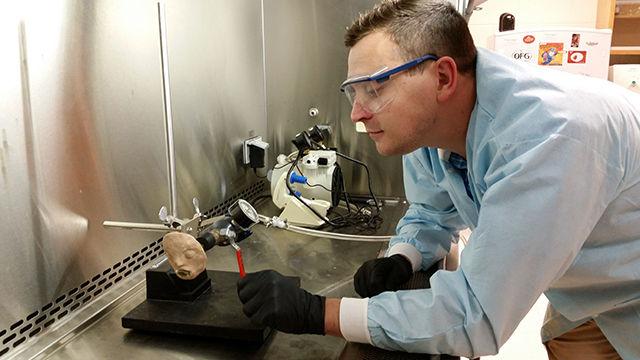 Dominic Libera demonstrates how the vomit machine works. The machine was designed to simulate human vomiting and determine how disease can be spread. The team worked to determine if viruses can be suspended in the air after the process of vomiting." />
Dominic Libera demonstrates how the vomit machine works. The machine was designed to simulate human vomiting and determine how disease can be spread. The team worked to determine if viruses can be suspended in the air after the process of vomiting." />
Contributed by Dominic Libera
Dominic Libera demonstrates how the vomit machine works. The machine was designed to simulate human vomiting and determine how disease can be spread. The team worked to determine if viruses can be suspended in the air after the process of vomiting.
Each year, more than 20 million people suffer from the horrible effects of the gastrointestinal illness known as the norovirus. For children and the elderly, the virus is responsible for nearly 1,000 deaths annually. Since the widespread outbreak of the norovirus in 2013, medical personnel across the country have done research to try to better understand the disease and how it is spread. Recently at NC State, a team of cross-discipline researchers made groundbreaking discoveries about the virus through somewhat unusual means — the vomiting machine.
The vomiting machine is a fairly self-explanatory device. Its purpose is to simulate human vomiting to allow scientists to study how diseases can be spread. NC State scientists were specifically trying to determine whether norovirus could be aerosolized through vomiting.
The hypothesis was that when vomiting occurs, viruses might be suspended in the air. Therefore, the norovirus could infect others if they simply breathed in those viruses. Other researchers had speculated that the disease could be spread through this method, but it had yet to be proven in the lab.
Under the direction of Lee-Ann Jaykus, professor of food science and expert on the norovirus, doctoral students Dominic Libera and Grace Tung-Thompson sought to prove the theory of aerosolization.
“Norovirus is shed in vomit and diarrhea,” Libera said. “You can get infected if you come in contact, but the question was, could you get infected through aerosolization? We built the vomit machine to test this theory.”
Libera’s role in the project was to build a functional vomit machine, while Tung-Thompson ran the experiments. Libera began designing the machine while he was completing his master’s degree in 2011. In the designing process, Libera relied heavily on advice from Kenneth Koch, a gastroenterologist from Wake Forest University.
“I would call Koch and have phone interviews with him,” Libera said. “He was the expert. I showed him the designs and he gave me feedback to make it better.”
In 2014, after two years of design and testing, the vomiting machine was complete and ready to be used in formal experimentation. The machine used tubes and pressure chambers to replicate the human mouth, esophagus and stomach.
Because working with the actual norovirus would require special labs, the research team chose to work with MS2, a bacteriophage that has similar characteristics to the virus. They placed the virus in substances of varying viscosities. This practice helped to simulate vomit at different levels of digestion. Through her experiments, Tung-Thompson determined that the disease was able to spread through aerosolization from vomit.
“By simulating vomiting using a device scaled to human physiological parameters, this study demonstrated that virus aerosolization did indeed occur,” Tung-Thompson said in her paper regarding the project.
While it was shown that only a miniscule percentage of the virus was aerosolized, thousands of viruses were suspended in the air. This meant that the virus could easily be spread through aerosolization since it takes only the ingestion of 10–20 virus particles to become infected.
The project was not only successful in the fact that it proved the theory of aerosolization but was also successful in showing the productivity of cross-discipline research. The team members working on the project came from diverse backgrounds. Libera was studying civil and environmental engineering while Tung-Thompson was studying food science. Neither necessarily had a strong background in medical research or the norovirus.
“I enjoyed this project because it was a new kind of field for me,” Libera said. “I was told I needed to build a vomit machine. I had to come up with an idea that worked even though it wasn’t necessarily in my field.”